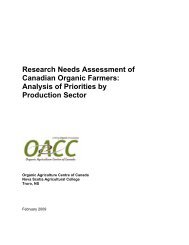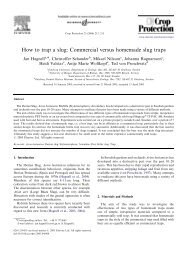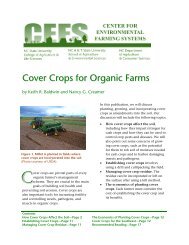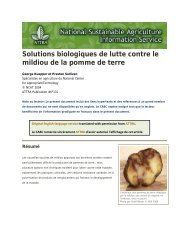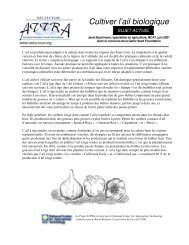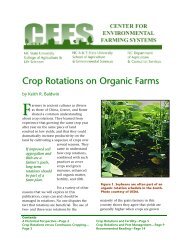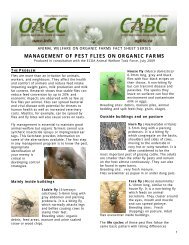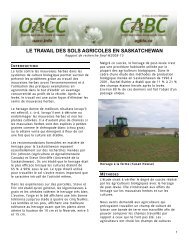• University of Georgia Cooperative Extensionwww.ces.uga.edu/pubcd/C677.htm• Louisiana <strong>Sweet</strong><strong>potato</strong> Commissionwww.sweet<strong>potato</strong>.org• University of California at Davishttp://fps.ucdavis.edu/sweet<strong>potato</strong>/background.html• Oklahoma State University Cooperative Extensionhttp://osuextra.com/pdfs/F-6022web.pdf• Oregon State Universityhttp://oregonstate.edu/Dept/NWREC/sw<strong>potato</strong>.html• University of Hawaii Extensionwww.extento.hawaii.edu/kbase/reports/sweetpot_prod.htmOrganic ProductionCultivars/PropagationGrowers should consult state Extension literature for cultivars recommended for a specific region.Only a few varieties show any resistance to pests (none to sweet<strong>potato</strong> weevil) or diseases (exceptwhere virus-free plants have been tissue-cultured).<strong>Sweet</strong><strong>potato</strong> propagation for U.S. farmers is from slips only. A recent Clemson introduction, ‘WhiteRegal’ sweet<strong>potato</strong>, can be stored for several months. This is a dry-fleshed variety with reported highresistance to fusarium wilt and the southern root-knot nematode. It also, reportedly, shows resistanceto internal cork virus, sclerotial blight, white grub larvae, wireworms, and cucumber beetles.(9) Productionof <strong>organic</strong> slips should be contracted well in advance of the growing season. In 2003, the firstfull year after national <strong>organic</strong> standards were finalized, many certifiers (including at least one statedepartment of agriculture) arranged for sources of plant starts for <strong>organic</strong> growers. In California,certified disease-free sweet<strong>potato</strong> propagation material is distributed by the California <strong>Sweet</strong><strong>potato</strong>Council (www.cayam.com) to its members, many of whom are <strong>organic</strong> growers.Smaller quantities of certified <strong>organic</strong> starts are available in some localities—particularly in California,where Ecology Action and other organizations offer <strong>organic</strong> sweet<strong>potato</strong> and other vegetable starts.Since the inception of the National Organic Program, propagation material, especially plants, has beenin extremely short supply, and a grower without a connection to a university with a micropropagationunit may be out of luck.As a last resort, some <strong>organic</strong> growers attempt to propagate their own sweet<strong>potato</strong> slips from savedtubers. However, if growers are using slips that have been cut from roots saved over several generations,mutations (common in sweet<strong>potato</strong>) begin to accumulate, and root quality declines. This hasbeen demonstrated in research and is one of the driving forces behind development of micropropagationunits like the ones at North Carolina State and the University of California. Growers term themutation accumulation “running out.” Expression of the “good” genes is masked by expressions ofmutated genes (10), sometimes leading to the knarled, misshapen, skinny offerings in farmers’ markets.Detailed information on propagation basics may be found at one of the international Internetsites aimed at large-scale commercial <strong>production</strong>, such as www.apcaem.org.Note that shipping of sweet<strong>potato</strong> propagation materials across state lines is subject to inspectionand strict regulation by USDA (see www.aphis.usda.gov/npb/F&SQS/alsq.pdf).PAGE 6ATTRA //SWEETPOTATO: ORGANIC PRODUCTION
Disease control begins with disease-free planting stock. California, the leading <strong>organic</strong> sweet<strong>potato</strong>producer, leads in practical research applications for its growers—for example, the FPMS <strong>Sweet</strong><strong>potato</strong>Program at UC–Davis. Certified virus-free propagation material was developed through theCalifornia <strong>Sweet</strong><strong>potato</strong> Council (www.cayam.com) and since 1995 has been distributed to members bythe Foundation Plant Marketing Service of the University of California. For details of the program,see http://fps.ucdavis.edu/sweet<strong>potato</strong>/background.html.Recent research by CIP personnel in China has shown that sweet<strong>potato</strong> yield can be increased by asmuch as 30 to 40% without additional fertilizer, pesticide, or genetic improvement. In a five-year projectin the provinces of Anhui and Shandong, using a procedure that eliminates viral diseases from plantingmaterials, scientists were able to develop virus-free cuttings that developed into healthy plants.If extended to all of China’s sweet<strong>potato</strong> growing regions, benefits exceeding $1.5 billion could berealized. This development would considerably reduce the country’s reliance on cereal imports forlivestock feed. See www.cgiar.org/research/res_sweetp.html.Soil Fertility and Fertilization<strong>Sweet</strong><strong>potato</strong>es do best on light, deep, friable loams (sandy loam) with high fertility. Barnyard manuresand composts have a history of use in sweet<strong>potato</strong> <strong>production</strong>. Ware and McCollum (11) notethe common practice of applying manure in a furrow under the ridge at rates of 2 to 4 tons per acre,cautioning that applications on already fertile loams can lead to oversized and irregularly shapedroots. In certified <strong>organic</strong> <strong>production</strong> there are special, detailed restrictions on the use of uncompostedmanure. See the ATTRA publication Manures for Organic Crop Production.Ware and McCollum (11) also advise using legume green manures when growing on sandy soils. Thegreen manure should be disked in or plowed down at least one month before the plants are set out.For more details, see ATTRA’s Overview of Cover Crops and Green Manures. University of Hawaii Extensionrecommends that legume green manures not follow sweet<strong>potato</strong> in rotation, since sweet<strong>potato</strong>inhibits N-bearing node formation. According to University of Hawaii Extension:<strong>Sweet</strong><strong>potato</strong> residues may prevent nodulation in nitrogen fixing crops, which should be takeninto account when designing a rotatation schedule. Crops traditionally rotated with sweet<strong>potato</strong>in Hawaii include lettuce, spinach, beets, radish, kai choy, sweet corn, cowpea, peanut, bean,sorghum, alfalfa, and pigeon pea. Crops following sweet<strong>potato</strong> in a rotation scheme should becarefully selected considering sweet<strong>potato</strong>’s allelopathic characteristics.www.extento.hawaii.edu/kbase/reports/sweetpot_prod.htmPublication of first results from a multi-year study at NCSU by Treadwell and Creamer—comparing<strong>organic</strong> compost only, an <strong>organic</strong> hairy vetch and rye cover-crop mix incorporated before planting,and the same cover-crop mix in a reduced-tillage system, compared with a conventional control—isexpected sometime in 2005. Research on other aspects of nutrient management is ongoing.(6)Wireworm density also affects yield. For additional information on soil fertility management in <strong>organic</strong>systems, see ATTRA’s Sustainable Soil Management, Organic Crops Workbook, Overview of Organic CropProduction, Manures for Organic Crop Production, Drought Resistant Soils and Overview of Cover Cropsand Green Manures (www.attra.ncat.org).Tillage and Weed Management<strong>Sweet</strong><strong>potato</strong> is usually planted on preformed ridges, maintained at the proper height and shape byearly-season cultivation. One or two cultivations as plants are becoming established helps them getahead of the weeds and shade them out—the first cultivation by a week to 10 days after transplant-ATTRA//SWEETPOTATO ORGANIC PRODUCTION PAGE 7



